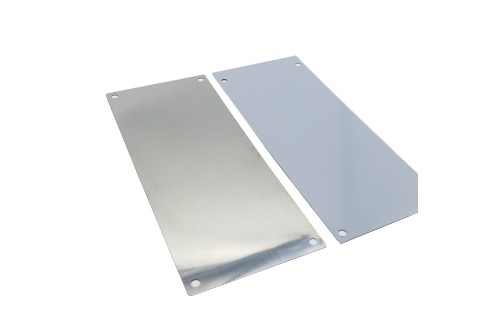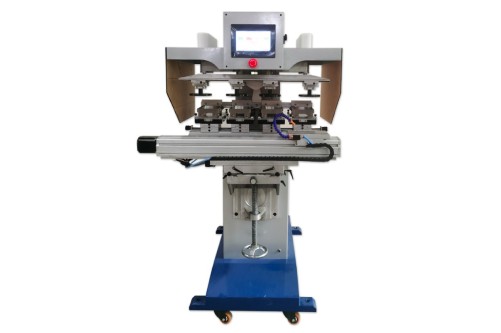Introduction
Pad printing is a versatile method utilized across various industries for its ability to transfer images onto irregularly shaped surfaces with high precision and durability. At the heart of the pad printing process are the cliché plates, which play a crucial role in ensuring the quality and efficiency of prints. This article delves into the significance of cliché plate manufacturing techniques and their impact on overall printing efficiency.

Understanding Cliché Plate Manufacturing Techniques
Cliché plates, also known as printing plates, are the essential components of pad printing machines. They are responsible for holding the image to be printed and transferring it onto the substrate. Several manufacturing techniques are employed to create these plates, each with advantages and considerations.
· Etching: Etching is a traditional technique that involves chemically engraving the image onto a metal plate. This method offers high precision and durability, making it ideal for long production runs.
· Laser Engraving: Laser engraving utilizes laser technology to etch the image onto the plate. It provides exceptional accuracy and suits intricate designs and small print runs.
· Photopolymer: Photopolymer plates are created through a photosensitive process where UV light hardens the polymer to form the image. This method offers quick turnaround times and cost-effectiveness for shorter print jobs.
These manufacturing techniques directly impact the quality, durability, and cost of cliché plates, thereby influencing the overall efficiency of the pad printing process.
Impact on Printing Efficiency
The manufacturing technique employed for cliché plates significantly impacts printing efficiency across several vital aspects.
· Precision and Accuracy: High precision and accuracy are paramount in pad printing, especially when reproducing intricate designs or fine details. Etched cliché plates, known for their precise image reproduction, ensure consistent print quality, minimizing rework and wastage. Laser engraving offers similar precision, making it suitable for complex designs requiring sharp details. Conversely, photopolymer plates may exhibit slight variations in image reproduction due to their softer material, impacting overall printing consistency.
· Durability and Longevity: The durability of cliché plates directly affects production uptime and maintenance costs. Etched and laser-engraved plates, crafted from durable metals like steel or tungsten, withstand prolonged use without significant wear. This longevity reduces the frequency of plate replacements, minimizing downtime and production interruptions. In contrast, photopolymer plates may wear out more quickly, requiring frequent replacements and maintenance, disrupting workflow and increasing operational costs.
· Production Speed: Efficiency in pad printing is closely tied to production speed, particularly in high-volume environments. Etched and laser-engraved cliché plates, with their superior durability and precise image transfer, enable rapid printing speeds, maximizing throughput and productivity. This ensures timely delivery of orders and enhances overall operational efficiency. Conversely, the softer nature of photopolymer plates may limit printing speeds, especially for large-scale production runs, resulting in slower turnaround times and reduced efficiency.
Considerations for Purchasing Cliché Plates
When selecting cliché plates for pad printing applications, it is essential to consider the manufacturing technique to optimize printing efficiency.
· Printing Volume and Frequency: Businesses with high printing volumes or frequent job changes may benefit from etched or laser-engraved cliché plates due to their durability and quick setup times. Conversely, photopolymer plates may be more suitable for lower-volume printing or prototyping projects where cost-effectiveness and fast turnaround are prioritized.
· Complexity of Designs: Intricate designs with fine details require cliché plates that can accurately reproduce the image. Etched and laser-engraved plates excel, offering precise image transfer and sharp definition. However, photopolymer plates may provide a cost-effective solution with satisfactory results for simpler designs or large solid areas.
· Budget Constraints: The cliché plate manufacturing technique also depends on budget considerations. While etched and laser-engraved plates may incur higher initial costs due to the materials and technology involved, they offer long-term cost savings through reduced maintenance and replacement expenses. On the other hand, Photopolymer plates provide a more affordable option for businesses with limited budgets or short-term printing needs.
Careful evaluation of these factors will help businesses select the most suitable cliché plates from pad printer plate suppliers to optimize printing efficiency while staying within budget constraints.
Case Studies and Examples
To illustrate the impact of cliché plate manufacturing techniques on printing efficiency, let’s explore some real-world examples.
Example 1:
A packaging company specializing in high-volume printing of logos and product information on plastic containers invested in laser-engraved cliché plates for their pad printing machines. The precise image reproduction and durability of the laser-engraved plates allowed for uninterrupted production runs, resulting in significant time savings and increased throughput. As a result, the company could meet tight deadlines and fulfil customer orders efficiently.
Example 2:
A promotional products manufacturer opted for photopolymer cliché plates for their pad printing operations to accommodate frequent design changes and small batch sizes. While the photopolymer plates offered cost-effective setup and quick turnaround times, they exhibited signs of wear after extended use, leading to print inconsistencies and increased downtime for plate replacements. As a result, the company experienced delays in fulfilment of orders and higher maintenance costs.
These examples highlight how the choice of cliché plate manufacturing technique can directly impact printing efficiency and overall operational performance in different production environments.
Future Trends and Innovations
Advances in cliché plate manufacturing are poised to enhance printing efficiency and productivity further.
· Advanced Materials: Researchers are exploring new materials with enhanced durability and print quality for cliché plates. Nanotechnology and composite materials promise to improve wear resistance and image transfer, leading to longer-lasting plates and higher printing efficiency.
· Digital Integration: Integrating digital imaging technologies with cliché plate manufacturing processes enables precise image reproduction and faster turnaround times. Computer-aided design (CAD) and additive manufacturing techniques allow for rapid prototyping and customization of cliché plates, catering to diverse printing requirements with improved efficiency.
· Automation and Robotics: Automation and robotics play an increasingly significant role in cliché plate production, streamlining manufacturing processes and reducing human error. Automated etching and engraving systems offer higher throughput and consistency, improving printing efficiency and reducing lead times.
These future trends and innovations hold the potential to revolutionize cliché plate manufacturing and elevate printing efficiency to new heights, driving advancements in pad printing technology.
Conclusion
In conclusion, cliché plate manufacturing techniques are pivotal in determining overall printing efficiency in pad printing applications. The choice of manufacturing technique impacts precision, durability, and production speed, directly influencing operational performance and cost-effectiveness. By carefully evaluating printing volume, design complexity, and budget constraints, businesses can select the most suitable cliché plates to optimize printing efficiency and meet the demands of their production environments. Additionally, ongoing advancements in materials, digital integration, and automation offer promising avenues for further enhancing printing efficiency and driving innovation in pad printing technology. By staying abreast of these developments and leveraging the latest manufacturing techniques, businesses can remain competitive in the ever-evolving landscape of pad printing.







